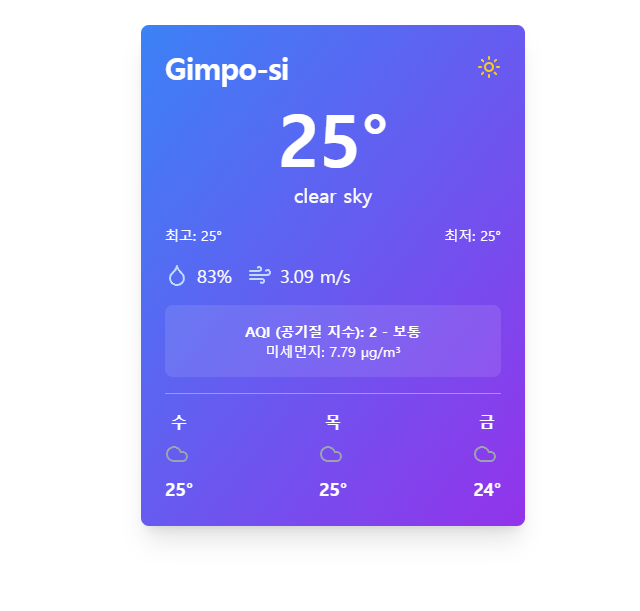첫번째로 사이트에서 APIKEY를 가져와야 한다.
위의 링크를 타고 들어가서 회원가입을 한 후에 자기 닉네임 -> my API Keys 에 들어가서 API 키를 가져오면 된다.
1. 위치 정보 가져오기
-
우선 사용자의 현재 위치를 가져오기 위해
navigator.geolacation.getCurrentPosition메서드를 사용한다. -
이 메서드는 사용자의 위치 정보를 가져와 lat(위도), lon(경도) 값을
location상태에 저장한다. 이때 위치 정보 가져오기에 실패할 경우 오류 메시지를 설정한다
useEffect(() => {
const getLocation = () => {
if (!navigator.geolocation) {
setError('Geolocation is not supported by your browser');
return;
}
navigator.geolocation.getCurrentPosition(
(position) => {
setLocation({
lat: position.coords.latitude,
lon: position.coords.longitude,
});
},
() => {
setError('Unable to retrieve your location');
}
);
};
getLocation();
}, []);2. 날씨 및 공기질 데이터 가져오기
-
위치 정보가 설정되면, OpenWeatherMap API 호출하여 현재 날씨, 공기질, 3일간의 에보 데이터를 가져온다.
-
데이터를 가져오기 위해
fetchAPI를 사용하며, 비동기적으로 모든 API 호출이 완료될 때 까지 기다리기 위해Promise.all을 사용한다.
useEffect(() => {
const fetchData = async () => {
if (!location) return;
try {
const { lat, lon } = location;
const weatherUrl = `https://api.openweathermap.org/data/2.5/weather?lat=${lat}&lon=${lon}&appid=${apiKey}&units=metric`;
const airQualityUrl = `https://api.openweathermap.org/data/2.5/air_pollution?lat=${lat}&lon=${lon}&appid=${apiKey}`;
const forecastUrl = `https://api.openweathermap.org/data/2.5/forecast?lat=${lat}&lon=${lon}&appid=${apiKey}&units=metric`;
const [weatherResponse, airQualityResponse, forecastResponse] =
await Promise.all([
fetch(weatherUrl),
fetch(airQualityUrl),
fetch(forecastUrl),
]);
if (
!weatherResponse.ok ||
!airQualityResponse.ok ||
!forecastResponse.ok
) {
throw new Error('Failed to fetch weather or air quality data');
}
const weatherData = await weatherResponse.json();
const airQualityData = await airQualityResponse.json();
const forecastData = await forecastResponse.json();
setWeatherData(weatherData);
setAirQualityData(airQualityData);
setForecastData(forecastData);
setLoading(false);
} catch (err) {
setError(err.message);
setLoading(false);
}
};
fetchData();
}, [location, apiKey]);
-
이 useEffect 훅은 location과 apikey가 변경될 때 마다 실행되며, fetch 함수를 이용해서 네트워크 요청을 만들어서 데이터를 가져오는 데 사용된다.
-
주로 RESTful API 서버와 통신하여 데이터를 가져오거나 전송하는 데 사용된다.
-
async 는 함수 앞에 붙여서 해당 함수가 비동기 작업을 수행함을 나타낸다.
-
async함수는 항상 Promise를 반환하며 비동기 작업이 완료되면 resolve 상태의 Promise를 반환하며 오류가 발생하면 rejected 상태의 Promise를 반환한다. -
Promise.all 을 사용해서 세 가지 데이터를 병렬로 가져온다. 병렬로 요청을 보내기 때문에, 순차적으로 요청하는 것보다 더 빠르게 데이터를 가져올 수 있다.
3. Json 데이터 파싱
const weatherData = await weatherResponse.json();
const airQualityData = await airQualityResponse.json();
const forecastData = await forecastResponse.json();
fetch요청으로부터 받은 응답은 JSON 으로 파싱한다. 이 과정도 비동기이기 때문에 await 키워드를 사용하여 처리한다.


